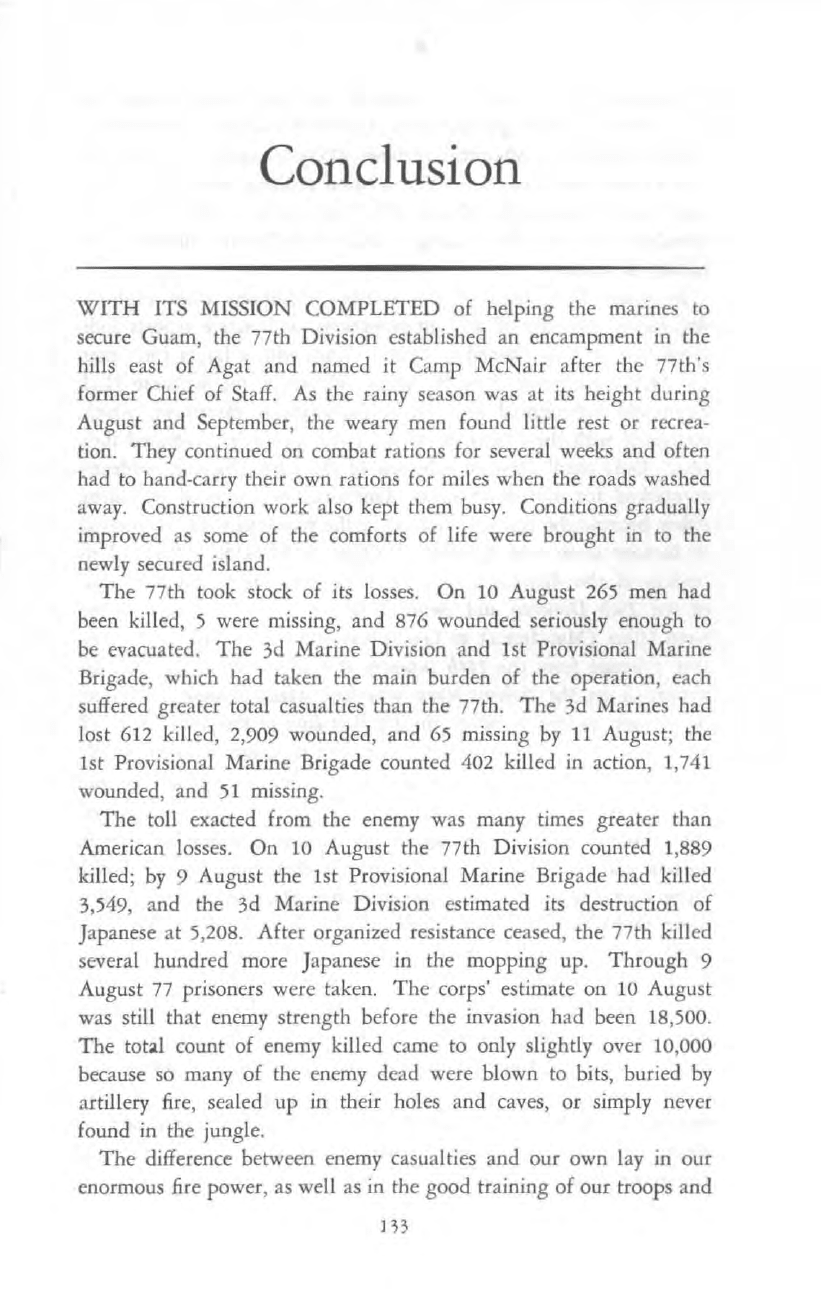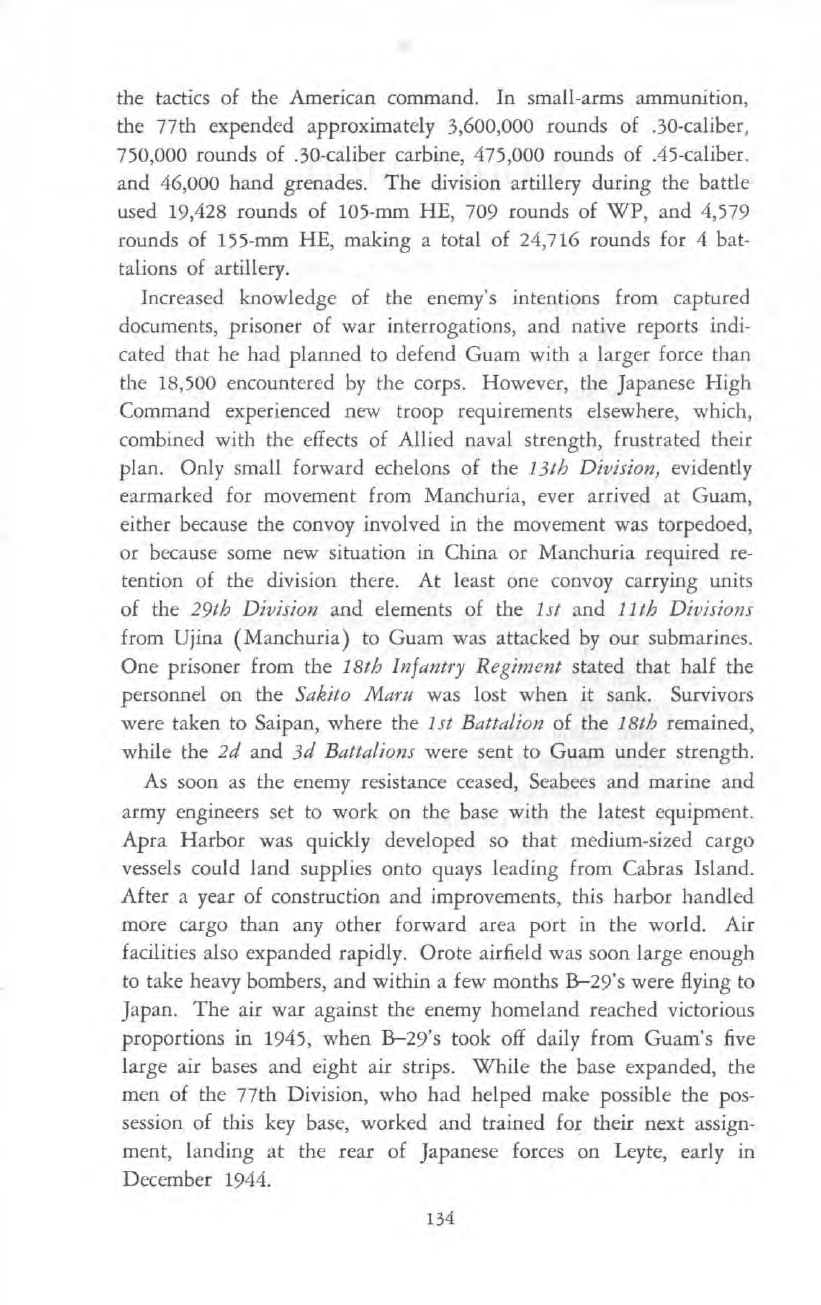Guam: Operations of the 77th Division, 21 July - 10 August 1944 (ENG)
Подождите немного. Документ загружается.


On 8 August, Radio Tokyo announced that American troops were
in
possession of nine-tenths of Guam.
On
10
August the marines
completed the occupation of their sectors on the north tip of the
island.
At
1500 on
10
August General Bruce received an order from
Southern Troops and Landing Force that all organized resistance
on Guam had ceased. However, the 77th and the marines were
still committed to mopping up of jungle areas and clearing
out
caves.
This task continued for several weeks. Although the surviving
Japanese were hungry and diseased, they continued to fight to the
death. After
10
August, the 77th Division suffered
52
more casu-
alties before they finished their assignment.
On 8 December 1945, three months after Japan had surrendered
unconditionally, some Japanese who had managed to hide out on
Guam for
16
months ambushed
and
killed 3 marines, wounding
another.
132

Conclusion
WITH
ITS MISSION COMPLETED of helping the mannes to
secure Guam, the 77th Division established an encampment
in
the
hills east of Agat and named it Camp McNair after the 77th's
former Chief of Staff.
As
the rainy season was at its height during
August and September, the weary men found little rest or
recrea-
tion. They continued on combat rations for several weeks and often
had to hand-carry their own rations for miles when the roads washed
away. Construction work also kept them busy. Conditions gradually
improved
as
some of the comforts of life were brought in to the
newly secured island.
The
77th took stock of its losses.
On
10
August 265 men had
been killed, 5 were missing, and 876 wounded seriously enough to
be evacuated.
The
3d Marine Division and 1st Provisional Marine
Brigade, which had taken the main burden of the operation, each
suffered greater total casualties than the 77th.
The
3d Marines had
lost 612 killed, 2,909 wounded, and
65
missing
by
11
August; the
1st Provisional Marine Brigade counted 402 killed
in
action, 1,741
wounded, and
51
missing.
The
toll exacted from the enemy was many times greater than
American losses.
On
10
August the 77th Division counted 1,889
killed;
by
9 August the 1st Provisional Marine Brigade had killed
3,549, and the 3d Marine Division estimated its destruction of
Japanese
at
5,208. After organized resistance ceased, the 77th killed
several hundred more Japanese
in
the mopping up. Through 9
August
77
prisoners were taken.
The
corps' estimate on
10
August
was still that enemy strength before the invasion had been
18,500.
The
total count of enemy killed came to only slightly over 10,000
because
so
many of the enemy dead were blown to bits, buried
by
artillery fire, sealed
up
in their holes and caves, or simply never
found
in
the jungle.
The
difference between enemy casual ties and our own lay in our
enormous
fire
power,
as
well
as
in
the good training of our troops and
lB

the tactics of the American command.
In
small-arms ammunition,
the 77th expended approximately 3,600,000 rounds of .30-caliber,
750,000 rounds of .30-caliber carbine, 475,000 rounds of .45-caliber.
and 46,000 hand grenades.
The
division artillery during the battle
used 19,428 rounds of 105-mm HE, 709 rounds of
WP,
and 4,579
rounds of 155-mm
HE
, making a total of 24,716 rounds for 4 bat-
talions of artillery.
Increased knowledge of the enemy's intentions from captured
documents
l
prisoner of war interrogations, and native reports indi-
cated that he had planned to defend Guam with a larger force than
the
18
,5
00 encountered
by
the corps. However, the Japanese High
Command experienced new troop requirements elsewhere, which,
combined with the effects of Allied naval strength, frustrated their
plan.
Only small forward echelons of the 13th Division, evidently
earmarked
for
movement from Manchuria, ever arrived at Guam,
either because the convoy involved in the movement was torpedoed,
or because some new situation in China or Manchuria required
re-
tention of the division there.
At
least one convoy carrying units
of the
29th Division and elements of the 1 st and
11
th Divisions
from Ujina (Manchuria)
to
Guam was attacked by our submarines.
One
prisoner from the 18th Infantry Regiment stated that half the
personnel on the
Sakito Marti was lost when it sank. Survivors
were taken to
Saipan, where the I st Battalion of the 18th remained,
while the
2d and
3d
Batta/iom were sent to Guam under strength.
As soon as the enemy resistance ceased,
Sea
bees and marine and
army engineers set to work on the base with the latest equipment.
Apra Harbor was quickly developed so that medium-sized cargo
vessels could land supplies onto quays leading from Cabras Island.
After a year of construction and improvements, this harbor handled
more cargo than any other forward area port in the world. Air
facilities also expanded rapidly.
Orote
airfield was soon large enough
to
take heavy bombers, and within a few months &-29's were flying to
Japan.
The
air war against the enemy homeland reached victorious
proportions
in
1945, when &-29's took off daily from Guam's five
large air bases and eight air strips.
While
the base expanded, the
men of the 77th Division, who had helped make possible the pos-
session of this
key
base, worked and trained for their next assign-
ment, landing
at
the rear of Japanese forces on Leyte, early in
December 1944.
134

ANNEX
NO.
I
APA
AP
AT
BAR
CP
FBL
HE
LCI(G)
LCM
LCVP
LST
LVT
RCT
RJ
SOP
WP
Abbreviations
Transport, Attack
Armor-piercing
Antitank
Browning Automatic Rille
Command Post
Final Beachline
High Explosive
Landing Craft, Infantry (Gunboat)
Landing Craft, Mechanized
Landing Craft, Vehicle,
Personnel
Landing Ship, Tank
Landing Vehicle, Tracked
Regimental Combat Team
Road Junction
Standing Operating
Procedure
White Phosphorous
135

GUAM
• •
~
u.s. GOVERNMENT PAINTING
OFFICE
: 1990 250- 873
